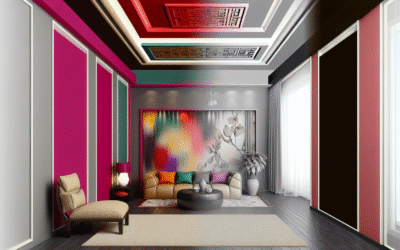
Blending Boundaries: The Art of Mixing Original Works and Prints in Modern Galleries
Are you looking to enhance your gallery experience by effectively blending original works and prints? The art world is evolving, and understanding this integration can unlock new avenues for engagement and appreciation. In this article, we will explore the nuances of “Blending Boundaries”, revealing both the challenges and methodologies to create compelling gallery displays.
By the end of this piece, you’ll have actionable insights into how to mix original artworks with prints artfully, aligning them to tell a cohesive story. We’ll provide a roadmap that includes tips on selection, placement, and the themes that resonate most with viewers.
Understanding the Art of Blending
In the intricate dance of art presentation, blending original works with prints is not simply a logistical choice; it’s a creative endeavor that can rejuvenate a gallery space. But first, let’s dive into the foundational elements:
The Role of Original Works
Original works are typically one-of-a-kind pieces that often carry deep emotional and monetary value. They serve as the backbone of a gallery’s collection.
The Appeal of Prints
Prints offer accessibility without compromising quality. They allow viewers to own a piece of art at a lower cost, creating broader audience engagement.
Benefits of Mixing Both
Combining these two categories can:
- Enhance visual interest
- Attract different audience segments
- Encourage discussions around artistry and techniques
Crucial Considerations for Blending Artworks
Artistic Themes
When curating your gallery, consider how themes can run parallel between original works and prints. Connecting them through aesthetics—such as color, texture, or subject matter—can create a harmonious narrative.
Scale and Size
Mixing sizes effectively is key. Consider how larger original pieces can be balanced with smaller prints horizontally or vertically. This interplay not only serves aesthetic purposes but can also guide the viewer’s journey.
Color Palettes
Color schemes that unify both originals and prints can create a seamless flow. Stick to a color palette and explore how each piece complements the other.
Implementation Strategies
Spotlight Techniques
One effective method includes using spotlighting for original works while keeping prints more subdued. This differentiation immediately draws attention while allowing prints to complement without overshadowing.
Collaborative Displays
Consider collaborative installations where original artists provide prints as part of an ongoing narrative or educational theme.
Interactive Elements
Augment your display with QR codes or AR elements that allow visitors to delve deeper into the stories behind both original works and prints.
Real-World Examples of Successful Blending
Case Study: The Tate Modern
The Tate Modern gallery in London offers an exemplary case where original pieces are displayed alongside prints to create dynamic exploratory spaces. Well-researched thematic exhibitions allow for deep engagement and dialogue.
Gallery Comparison: Private vs Public
Private galleries often focus on higher-value original pieces compared to public institutions. However, public galleries have started incorporating prints in accessible ways, creating an even playing field.
Measuring Success in Blending
Visitor Feedback
Understanding visitor feedback can shape future curation strategies. Surveys and comment cards can help gather specific suggestions regarding the display of original works versus prints.
Sales Data
Analyzing sales data of prints versus original works can provide insight into viewer preferences. Understanding which items resonate can guide future curatorial decisions.
Next Steps: Elevating Your Gallery Experience
Ready to start blending boundaries in your own gallery? Here are some practical steps:
- Start small: Begin with two or three pieces that share a theme.
- Experiment with placement, adjusting spacing and positioning as needed.
- Engage with artists to understand their intent behind both prints and originals.
Frequently Asked Questions
Why mix original works and prints?
Mixing originals and prints enhances visual interest, attracts diverse audiences, and encourages deeper engagement with the artworks.
How can I choose which prints to display?
Consider thematic resonance, color palettes, and size compatibility with the original works you plan to showcase.
What are the benefits of prints in a gallery?
Prints provide accessibility, broaden audience engagement, and offer a unique perspective on the original artworks.
How should I arrange original works and prints together?
Pay attention to scale, color cohesion, and thematic alignment when arranging artworks to create a harmonious display.
Can the blending approach work for other art forms?
Yes! This blending strategy can be applied to various art forms, including modern installations and mixed media.
Content Disclaimer
Information provided in this article is for educational purposes only. Consult professionals for personalized advice based on your unique circumstances.
Categories
- Accent Walls & Ceilings (61)
- Art Curation & Gallery (62)
- Bedding Style Trends (68)
- Bedroom Makeover (81)
- Bohemian & Eclectic Styles (58)
- DIY & Budget-Friendly Decor (64)
- Eco-Friendly Design (62)
- Furniture Care (71)
- Home Decor & Design Ideas (162)
- Home Wellness Spaces (59)
- Integrated Outdoor Living (67)
- Japandi Style (61)
- Kids and Nursery Decor (59)
- Living Room Decor (79)
- Mix & Match Techniques (73)
- Modern & Contemporary Design (66)
- Rug Sizing & Placement (73)
- Scandinavian Design Inspiration (20)
- Seasonal Home Decor (79)
- Small Space Solutions (73)
- Wall Art & Painting Tips (77)
Recent Comments
Archives
Product Gallery
-
Large Area Green Rugs for Bedroom Nordic Living Room Decoration Shaped Carpet Irregular Plush Lounge Rug Home Thick Washable Mat
Rated 5.00 out of 5$54.94 – $346.41Price range: $54.94 through $346.41 -
Nordic Style Rugs for Bedroom Morandi Living Room Decoration Carpet Large Area Geometry Lounge Rug Home Cloakroom Non-slip Mat
Rated 5.00 out of 5$39.46 – $597.66Price range: $39.46 through $597.66 -
Irregular Shapes Living Room Decoration Carpet Modern Style Rugs for Bedroom Home Thicken Plush Rug Fluffy Soft Lounge Floor Mat
Rated 4.83 out of 5$55.84 – $347.37Price range: $55.84 through $347.37














